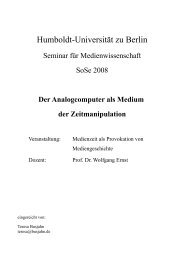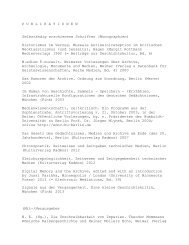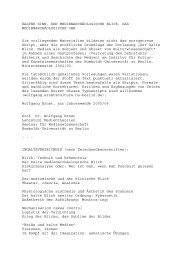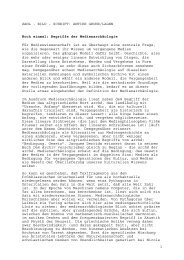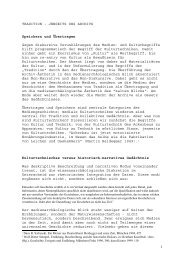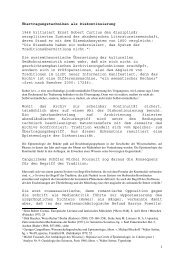Download - Medienwissenschaft
Download - Medienwissenschaft
Download - Medienwissenschaft
Create successful ePaper yourself
Turn your PDF publications into a flip-book with our unique Google optimized e-Paper software.
gic mirror' and 'window on the world' refer to the transparency of the glass surface of the<br />
receiver" 56 . "Actually, the whole edifice is just a display cabinet", it says in an architectural<br />
critique of the glass-dominated Sony Center at Potsdamer Platz, Berlin. It is notable<br />
what happened within this space: One part of the building (the Kaisersaal) of the former<br />
Hotel Esplanade, which was situated on the company's property and a listed building,<br />
was moved by 70 meters at great expense in order to make room for a road, and integrated<br />
into one of the new wings. Still original, this artefact has now turned into a quotation,<br />
into a copy of itself: and consequently, the wording for this hybrid in the space<br />
between original and copy is Architekturmuseum. 57<br />
Indices of the Real<br />
For the first time, optical media since photography make it possible to record the real of<br />
light. In analogue photography, it is the index, i.e. the unique pointer to something real,<br />
that authorises the medium. "In contrast to symbols, indices produce their significance<br />
on the basis of a physical relationship with their referents." 58 In that sense, the video<br />
magnetic tape is equally indexical (if not iconic, since it entertains no visual similarity to<br />
its model), the store of a real impulse track or "marking". In turn, the electronic video<br />
image on the monitor is - like the television image - in the tradition of Kepler's eye<br />
image theory, since it is not an image-producing process, but scans real impulses:<br />
The pictura produced by light in the eye entirely according to geometrical laws [...]<br />
is on the one hand, via the incoming rays [...] clearly related to the pictured subject in the<br />
exterior world, its object of reference, on the other hand it acquires at the same time an<br />
independent existence of its own. 59<br />
With the video disk, it is crucial for digitally encoded image and sound information<br />
is scanned by the laser beam without loss, also with regard to time; "a linear time structure<br />
no longer exists" 60 . On this level, therefore, applies - in variation - Roland Barthes'<br />
notion of the uncoded message of the photographic image: "that the relationship of significant<br />
and significate is, as it were, a tautology: [...] not a transformation (which an encoding<br />
could be); [...] one is faced with the paradox ... of a message without a code." 61<br />
While the physical nature of the natural world is still expressed in the photochemical<br />
emulsion, giving the photographic imprint its documentary, indexical status, this mark is<br />
ephemeral in technological images. Because "photographs are produced under conditions<br />
that force them physically to correspond point by point to the original," - as stressed<br />
by Flusser's photo theory - they belong to the sign class of indices "which are signs<br />
on the basis of their physical connection" 62 - and hence are not identical with the icon<br />
whose effect derives from the similarity of the picture, not necessarily from its material<br />
connection.<br />
An Index is a sign which refers to the Object that it denotes by virtue of being really<br />
affected by that Object. It cannot, therefore, be a Quality, because qualities are whatever<br />
they are independently of anything else. In so far as the Index is affected by the<br />
Object, it necessarily has some Qualities in common with the Object, and it is in respect<br />
to these that it refers to the Object.<br />
-159-





